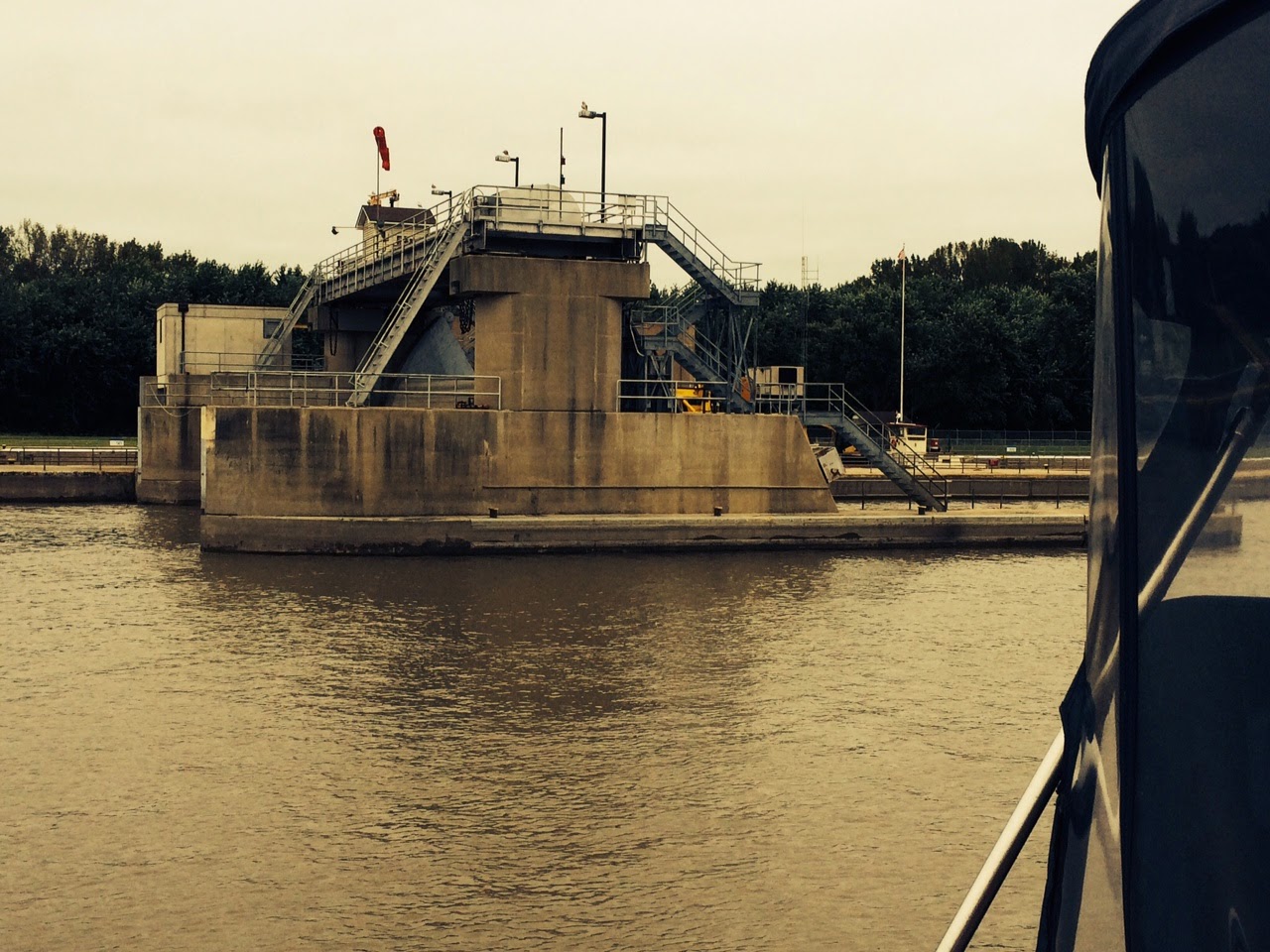Well, we may not have gotten much rain yesterday, but further downstream, the Missouri River as it enters the Mississippi River is flooded. Some areas in the lower Missouri had 6 inches of rain in one 24 hour period. The Illinois River is also near flood stage, and since the Illinois and Missouri Rivers flow into the Mississippi within 15 miles of each other, this has created some lock closures and LOTS of debris on all of the river. Thus, the down river marinas are full of Loopers who are "stuck" there waiting for the flood waters to recede. Therefore, when we headed to Havana, we knew in advance that we might be there a few days waiting for the flood waters to recede downstream.
Our trip today was 48.1 miles, and it included the Peoria Lock with a drop of 11 feet and 8 bridges. As we approached the Peoria Lock, we passed under the Shade-Lonman Twin Bridges with the Peoria Lock just visible under the lower left side of the central spans of the bridges (picture at right). You may have noticed that I have not mentioned the dam associated with this lock. The dam is a "wicket dam", which means that the dam can be rotated about hinges at the upstream (or bottom) end of the dam. Since we are near flood stage for this lock, the dam has been lowered and we will pass right over the dam and not need to use the lock.
Yup, the tow on the right side of the picture above is headed toward us in the upstream direction, and it has just crossed the wicket dam. The picture on the left shows the lock on the left half with several work barges in the lock chamber. On the right hand side of the picture is a lift gate. The wicket dam is to the right of the picture. In this case there were about 8 individual wickets that are raised up to block (or dam up) the water. As you might imagine, the first few wickets are easy to raise, but as the flow is restricted and water begins to rise, the remaining wickets are harder to raise. To make this process easier, the lift gate on the right side of the picture is the last part of the dam to close.
The picture at the right shows Lucky Us about to pass over the wicket dam. You are now looking at the side of the lift gate in the previous photo, and the lock is in the background. It was such an interesting (or exciting?) event that I forgot to look at the depth sounder as we passed over the wickets... Anyway, we had slowed down, but it was certainly faster than going through the lock would have been.
The picture on the left was taken a few seconds after the one above, and it shows the view out the other side. In this view the wickets the wickets would rotate up from left to right (upstream) and fill in the river up to the concrete wall. After the wicket dam, we had only two more bridges in 4.8 and 6.7 miles. By then we were past the City of Peoria and has passed under 8 bridges in 14.5 miles, which is not a large number of bridges for a "real" city.
Once we had passed under that last bridge, we could pretty much enjoy the ride on the fast flowing (current about 2.2 mph) Illinois River for the remaining 31 miles of today's trip. There was debris in the river, but fortunately, most of it was small branches with very few tree trunks to worry about.
We arrived at Tall Timbers Marina in Havana, Illinois a little after Noon, and we walked about 4 blocks to have lunch at Trixie's Cafe. After lunch, we stopped at Ace Hardware to buy some stainless steel hose clamps (6) and 2 feet of 5/8 inch inside diameter black (radiator?) hose for the diesel engines. When I started my generator repair project, the first thing to check was for a blocked/clogged PCV valve. So, in the process of doing that check for the generator, I also cleaned the PCV valves on the main engines and replaced several worn and cracked hoses and clamps. Of course, the hoses were a total of 3 different sizes (3/8, 1/2 and 5/8 inches, inside diameter). We had the big and little hoses in our trusty spare engine parts box. So, with the new hose and more clamps, I was quickly able to finish replacing the last of the hoses. The picture at the right shows the cracking through the original red (main engines) and white (generator) paint. At the bottom end of the top hose you can even see where a piece of the hose is missing.
Then it was time for naps for everyone...





No comments:
Post a Comment